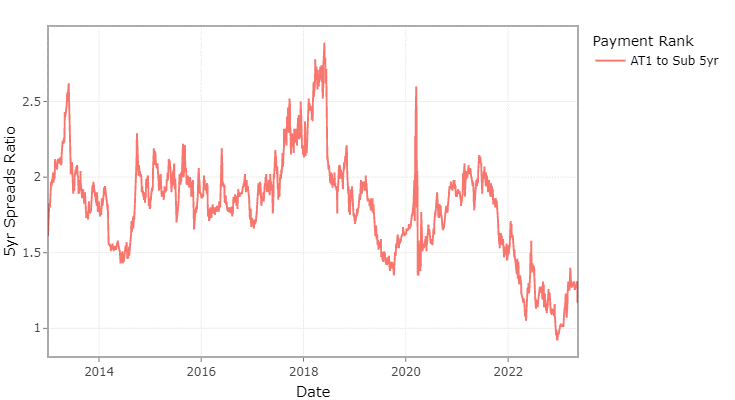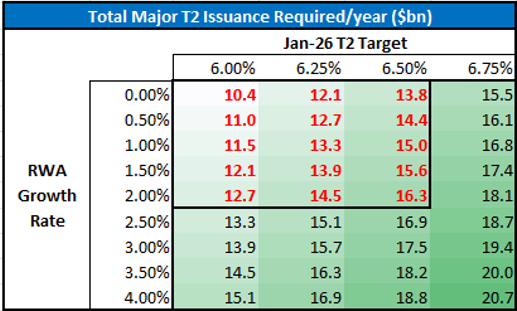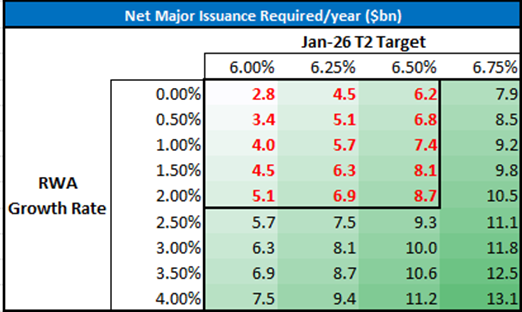Bank bond issuance could slow sharply
Banks issue bonds to fund their balance-sheet growth alongside funding they source from deposits. Bank treasury teams are notoriously poor at forecasting balance-sheet growth and tend to suffer periods of under- or over-issuing. We are both observing and projecting a dramatic slow-down in Aussie bank balance-sheet growth, which could materially reduce both their senior and Tier 2 bond issuance needs in the next few years.
There has been a striking slow-down in Aussie bank balance-sheet growth on a rolling, six month annualised basis from circa 10.6% per annum in April 2022, just before the RBA began to hike rates, to 4.2% per annum as at March 2023. The majors have been growing even more slowly at a 3.8% annualised pace over the half-year to March with Westpac only realising a sluggish 1.4% annualised lending growth over this same period.
Balance-sheet growth is likely to decelerate further to 2% per annum or less as the RBA's record 375bps of hikes begin to bite. There is also a real risk that the central bank continues to nudge-up rates given recent freedom of information disclosures that it considers a 3.8% cash rate (we are at 3.85% currently) to be the "neutral" cash rate that is unlikely to quell inflation sufficiently for it to meet its 2-3% CPI target by 2024 or 2025.

The question is what does this mean for the banks' bond issuance?
We model the banks wholesale funding needs, which includes all forms of debt issuance, and their Tier 2 bond requirements in particular. Our central case is that balance-sheet growth decelerates to 2'% per annum or less with the risk that we go through a period of no growth at all. The major banks are targeting holding Tier 2 capital worth about 6.5% of their risk-weighted assets. However, Tier 2 bonds are substitutable with hybrids or Additional Tier 1 (AT1) capital. And AT1 hybrid spreads are at historically low levels compared to Tier 2 bond spreads (ie, they are cheap for banks to issue whereas Tier 2 is expensive). The chart below shows the ratio of the spread of 5-year major bank hybrids compared to 5-year major bank Tier 2 bonds. It is normally around 1.8x. Today it is about 1.3 times.

So one might expect the major banks to issue a little more AT1 hybrid capital in the next year and a little less Tier 2. Consider CBA's new hybrid deal, launched today at 3% over the bank bill swap rate (BBSW) for an all-in yield of about 6.9% per annum franked.
The current coupon on the new CBA hybrid is 6.9% per annum, of which 4.8% is a cash payment before franking credits, which are worth 2.1%. The 4.8% cash cost to CBA represents a spread of 0.9% per annum above BBSW, which is much cheaper than issuing a Tier 2 bond at 2.35% above BBSW, as ANZ recently did. Post-tax, the cost is of course different.
So banks are targeting raising Tier 2 capital worth about 6.5% of their risk-weighted assets (RWA) by January 2026. At 3% annual balance-sheet growth, that implies about $17.5bn of issuance each year, which is almost exactly their average issuance volumes over the last 3-4 years. But if we likely see a combination of 1/ much slower balance-sheet growth of 0-2% per annum and 2/ a marginal substitution towards more AT1 hybrid issuance (noting there are no major bank maturities on the ASX this year that will encourage a pivot from T2 to AT1), then we could see less Tier 2 bond issuance. This could range from as little as $10.4bn ($2.8bn net) per annum (0% RWA growth and 6% T2) to $16.3bn ($8.7bn net) per annum (2% RWA growth and 6.5% T2).


4 topics

